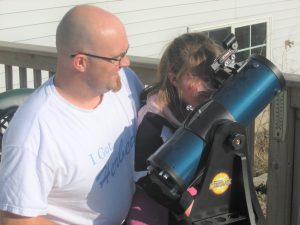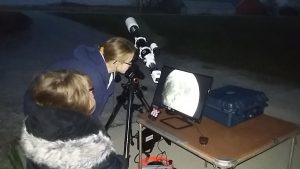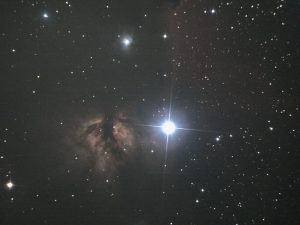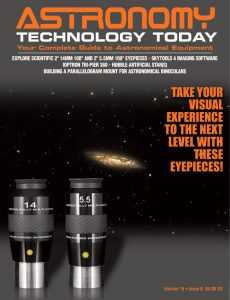“Seventeen years ago, I was blessed with a daughter having special needs.”
Though the quiet solitude of losing ourselves in the night sky’s depths is undeniably magical, sharing our love of outer space with others has its own unique rewards. We may share with complete strangers, inexperienced friends, or even old salts who have forgotten more than we’d ever hope to know about astronomy.
Talking about outreach might evoke an image of crowds lined up behind a telescope, patiently waiting in the darkness for an opportunity to peer through the eyepiece. How might the event differ if that line included wheelchairs, flashlights, and respite providers guiding their charges down a path cloaked in darkness?
The goal of this article is to raise the issue of visual and physical accessibility in the context of astronomical outreach, and to describe ways in which video astronomy can enhance that accessibility. That said, I will be constraining my general discussion to viewers with low vision, fine/gross motor challenges, and/or limited mobility. I do so for two reasons. First, we have limited space. Second, I have a personal, vested interest in serving folks experiencing physical and/or visual challenges.
My Story (or Bias)
Seventeen years ago, I was blessed with a daughter having special needs. She is an enigmatic, energetic, and often entertaining young woman with complex health challenges limiting her mobility, vision, and spatial perception. From the time she was little, her favorite book was a tome full of oversized Hubble imagery. Though the book’s size warranted transport with a “wide load” banner and flashing lights (maybe I’m exaggerating a little bit), its large images, coupled with a brilliant color palette, mesmerized her.

Though perusing the book was great fun for us both, I longed to help my daughter experience the sky at the scope. I do, and will always, adore visual astronomy: “Cruising” above the cloud-tops of M42 while the trapezium silently drifts past my 524x porthole is simply beyond words. Such are the experiences I want/wanted to share with all of my children. This goal of inclusion led me to experiment with various platformed ladders, handholds, and progressively more expensive eyepieces…solutions great for many, but still insufficient to achieve the access that I hoped for.
Through our pursuit of the heavens, I’ve made countless attempts with my varied scopes to establish access to the eyepiece.
These scopes include the custom 406mm Dobsonian shown in Image 1, a Celestron 150mm achromat overloading its stock GEM, a goto-mounted Sky-Watcher 100mm ED, and even the Orion 114mm tabletop reflector in image 2.
Image 2 presents a fond memory, one where I was trying to teach my daughter (then 7 years old) how to position her eye in front of our Starblast’s focuser. In theory, practicing physical positioning in the daylight (while pointing away from the sun) without an eyepiece should enhance success with eye placement and viewing at night. Sadly, all seemed in vain: The only object that I can confidently say she has seen in an eyepiece is Comet Holmes over a decade ago.

I’d like to say that our journey toward accessibility has been unique, but such is not the case. The topic was recently discussed in the MallinCam user group, with many insightful perspectives shared. I’ve paraphrased a few that particularly resonated with me:
Woody Schlom – Regardless of cognitive ability and focuser adjustment, some individuals simply have a hard time focusing on images within an eyepiece. There’s just *something* about that aerial image that makes viewing difficult for some viewers.
Jim O’Connor –In a defining moment, a college student in a wheelchair couldn’t access an outreach telescope’s eyepiece. That is, she couldn’t until her friends (with permission) lifted her by the elbows and held her to the eyepiece. Physical access, developed capacity for out-of-context visual discrimination, visual health conditions (e.g., cataracts, macular degeneration, etc.) and a litany of other factors can render eyepiece views underwhelming at best, and impossible at worst.
Lorence —Bending, stretching, and ladder access to eyepieces can be difficult for the young and healthy. Ask yourself: Would you feel comfortable sending Grandma up a ladder in the dark?
What to do?
It comes as no surprise that those with visual and physical impairments can experience challenges when viewing the night sky. In researching this article, I found that the ‘net is replete with brief attestations of VA’s contribution to accessibility, yet most stopped short of discussing the topic in detail.
Furthermore, many of the more informative articles, books, and websites that I reviewed were dedicated to innovative, hands-on experiences and/or ingenious eyepiece/focuser-based solutions designed to facilitate accessibility. Some notable examples include long fiber-optic eyepiece extenders, cantilever arms enabling more convenient eyepiece positioning, and powered lifts. In spite of some truly impressive solutions, critical challenges were left unaddressed:

1- Viewers may struggle with eye placement even when using an adaptive ocular device;
2 – Detecting oft-subtle contrasts found in astronomical targets is particularly challenging for those with low-light sensitivity (e.g., those with retinal dystrophy, etc.); and
3 – Even with accommodations in place that facilitate eyepiece access, the scope itself may still have to be set up in a location with a difficult approach.
Is there a solution that addresses the needs identified mention here, and maybe even more? Yes: Video astronomy fits this bill perfectly. For this article, video astronomy (VA) refers to live/near live rendering of camera-based astronomical imagery, such that the astronomical object is continuously refreshed on a video or computer monitor.
How Might Video Astronomy Meet One’s Needs?
Low-Vision, Head Positioning, and Image Scale
When watching my daughter view pages on her tablet, she prefers to hold the screen about 6 inches from her nose. Furthermore, she needs the flexibility of orienting her head at just the right angle to compensate for other structural nuances.
One of the exciting aspects of VA is that many cameras have an ability to project images onto a wide range of screens, sometimes without need for a computer. Be it a simple computer monitor or a 72-inch smart TV from Big Box Store, Inc., we have a multitude of viewing options. Such projection allows viewers to both orient their heads as needed and to unambiguously point out specific features in an image for further discussion. As well, viewers can adjust their distance from the screen so as to better experience what is being shown.
In image 3, I’ve captured my daughter’s lunar first light…yes, I was as excited for her as she was. As she leaned close to the monitor, I was curious how she’d respond (hence I had my cell phone’s camera ready). Upon leaning in, she traced Mare Imbrium’s shoreline with her finger, eventually zeroing in on Montes Apenninus with an exhortation of, “DAD!!! I SEE MOUNTAINS!!!” These mountains will forever be immortalized in her vernacular as “My Mountains”. For the first time, she could clearly see what was out there. And, with the ability to point directly to the screen, there was no ambiguity…I knew exactly what she was looking at and we readily shared in the experience.

When getting up-close-and-personal isn’t tenable, controlling software for many VA cameras enable on-the-fly digital zoom. Thus, if something particularly interesting emerges from the depths of space and viewers can’t move in close, or if a viewer simply desires a larger image scale, the astronomer can adjust image scale with the flick of a finger. Image 4 shows two of my daughters viewing the moon after zooming in a bit so that both could see. You may notice the absence of a computer: The MallinCam HD-10 lunar/planetary camera inserted into my Sky-Watcher 100ED Pro can be used with or without a computer.
Image Brightness and Contrast
Show of hands: How many of us have gotten excited over seeing that special faint-fuzzy, feeling energized because our experienced eye could pick out an ill-defined, misty patch at the very limits of visibility? Excitement from meeting a challenge is part of what drives us, forcing us to better ourselves. However, what if such views would be too faint or low in contrast for a viewer’s eyes to detect, even if the object is theoretically within reach of the scope?

Video astronomy addresses these issues by enabling astronomers to adjust image brightness, contrast, color, and other settings on-the-fly. For instance, Image 5 presents Alnitak and the Flame Nebula (NGC 2024) derived from a live stack of 3.25 second exposures using my 8” MallinCam newtonian and MallinCam DS10c video camera (with no coma corrector).
There’s a bit of noise due to high gain settings and the fact that this image was not processed after being captured during my live viewing session. While the image is pleasing to my eye, the Flame Nebula’s gossamer peripherals may be lost to those challenged by low-light contexts. An easy solution would be to simply increase gain or exposure time, thereby enhancing faint details. Granted, you might over-expose Alnitak or brighter portions of the Flame, but enabling all viewers to see fire in the sky during live sessions is quite exciting. We are fortunate that the sensitivity of many video cameras often translates into relatively short exposures, thus quickly rendering setting adjustments in the onscreen image
During this winter’s particularly cold, cloudy weather, I spent significant time with my special-needs daughter conducting an intentional, qualitative inquiry. We investigated how she experienced over 200 of my more recent lunar, planetary, and deep space images. From this effort (and concomitant background readings), I’ve seen how she, as well as others with low vision, can benefit from viewing images that are: (1) Colorful; (2) Bright (but not too bright); (3) High in contrast (but not too high); and (4) Relate to or look like something that is already familiar (e.g., the Flame Nebula).
Though making connections to familiar objects may require some creativity on the part of the astronomer, the first three characteristics arise from direct camera control…right there, live in-session.
With respect to that control, I want to present a warning regarding something I’ve seen firsthand. Some viewers with neurologic concerns experience a specific sensitivity to extremes in brightness/contrast combinations called “photophobia”. This condition doesn’t render an abnormal fear, but rather extreme sensitivity to the perception of light at a neurologic level. An afflicted viewer experiences aversion at best, and physical discomfort/nausea at worst, due to being neurologically over-stimulated by viewing something that is overly bright/contrasty.
During our inquiry, I showed my daughter an inverted version of a bright black/white lunar image that had been modified to darken maria. In presenting the inverted image, I forgot that my computer monitor was set to maximum brightness. The admittedly garish, high contrast/brightness post-inversion view elicited a strong negative reaction from my daughter, accompanied by slight vertigo and a mild headache. The effect was mitigated by her turning away from the picture and our avoiding any further inverted imagery. While photophobia isn’t a common condition, it is certainly something to keep in the back of your mind, especially when working with special needs populations.
Physical Access
Though there are many directions an astronomer can take to help viewers with visual challenges, simply providing safe physical access to astronomical equipment is of utmost importance. In years past, I had the good fortune to spend several evenings viewing through a 30” dobsonian while perched atop a tall folding ladder…experiences that were at once amazing and nerve-wracking.

My elevation-induced jitters were likely nothing compared to those experienced by the aforementioned young woman lifted to the eyepiece. While I cannot help but be impressed by her courage and determination in the moment, having to go to such extremes to look through an eyepiece can undermine someone’s enthusiasm. Thankfully, her experience was so powerful that she returned for additional viewing sessions that used more accessible setups.
Physical access is a particular strongpoint of VA. Many cameras come standard with control cables upwards of 15 feet in length, which means that the scope/camera/mount can be placed some distance from control and viewing gear. This enables astronomers to set the scope up and place any manner of viewing equipment on adjacent secure, smooth surfaces. With the availability of active USB cables and powered USB ports, modern cameras permit astronomers and viewers to be even more remote. In the field, you can easily control VA sessions from over 50 feet away with the purchase of a few relatively inexpensive electronic accessories and installation of user-friendly (often free) software.
While my depiction is a bit oversimplified, the takeaway is that VA practitioners do not need to move heaven and Earth to safely engage viewers when a scope’s physical location isn’t conducive to accessibility.
Discussing setups from a distance creates a mental image of telescopes strewn across the lawn, with connected computers and monitors rimming an adjacent parking lot or driveway. However, don’t limit your imagination to outdoor exposure…that, in-and-of-itself, can present its own challenges. As winter slowly claws an icy hole through our very souls, one or more of my children will ask me to “do astronomy.”
But, they don’t share Dad’s polar-bear disposition. As seen in Image 6, I meet this request by setting up outside our basement door, running my mount’s control paddle (with 10’ cable extension) and 15’ USB camera cable between the door and frame, and engaging the heavens from inside. Image 6 was taken during a viewing session when it was minus 5F…outside.

Please understand, I thoroughly enjoy the richness of full-immersion under the night’s tapestry, listening to choirs of coyotes and other nighttime denizens roaming fields and forests while I ward off the cold or duel aircraft-sized mosquitos. However, many physical conditions (e.g., circulatory, cardiac, immune system, etc.) render extended outdoor activity potentially unhealthy. In my case, I will readily put a roof between myself and the stars if it means continuing to safely share live views with my family.
Conclusion
It comes as no surprise that I see the universe as being at our fingertips, just waiting to be experienced by everyone in his/her own way. Finding that way is an ongoing, intentional journey. That journey might fit a normative model for some, yet require additional innovation for others. It would seem both responsible, and simply the right thing to do, to open heaven’s gates for all who might gaze skyward. Yes, I feel that video astronomy represents a golden key for those gates. But, don’t take my word for it…my daughter’s face says it all (Image 7).
 By Matt Harmston
By Matt Harmston
Matt Harmston is an educational researcher whose appetite for the heavens has been whetted by increasing aperture over the years. More recently, Matt has immersed himself in video astronomy – a means of probing deeper into the night sky while making astronomy accessible to all ages and abilities.
 And to make it easier for you to get the most extensive telescope and amateur astronomy related news, articles and reviews that are only available in the magazine pages of Astronomy Technology Today, we are offering a 1 year subscription for only $6! Or, for an even better deal, we are offering 2 years for only $9. Click here to get these deals which only will be available for a very limited time. You can also check out a free sample issue here.
And to make it easier for you to get the most extensive telescope and amateur astronomy related news, articles and reviews that are only available in the magazine pages of Astronomy Technology Today, we are offering a 1 year subscription for only $6! Or, for an even better deal, we are offering 2 years for only $9. Click here to get these deals which only will be available for a very limited time. You can also check out a free sample issue here.

